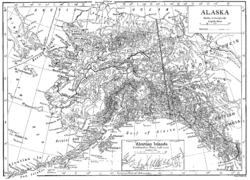Territory of Alaska
| Territory of Alaska | |||||
| Organized incorporated territory of the United States | |||||
|
|||||
|
Flag |
|||||
| Territory of Alaska | |||||
| Capital | Juneau | ||||
| Government | Organized incorporated territory | ||||
| Governor | |||||
| • | 1912–1913 | Walter E. Clark | |||
| • | 1958–1959 | Waino E. Hendrickson | |||
| History | |||||
| • | District of Alaska | August 24, 1912 | |||
| • | Statehood | January 3, 1959 | |||
 |
| History of Alaska |
|---|
| Prehistory |
| Russian America (1733–1867) |
| Department of Alaska (1867–1884) |
| District of Alaska (1884–1912) |
| Territory of Alaska (1912–1959) |
| State of Alaska (1959–present) |
| Other topics |
Flag
The Territory of Alaska or Alaska Territory was an organized incorporated territory of the United States that existed from August 24, 1912, until January 3, 1959, when it was admitted to the Union as the State of Alaska. The territory was created as the District of Alaska on May 17, 1884.
The passing of the 1899 Criminal Code, which among other things included a tax on liquor, led to increased calls for Alaskan representation in Congress, and the debate finally ended on August 24, 1912, when the Alaska Territory became an organized, incorporated territory of the United States.
The Second Organic Act of 1912, renamed the District of Alaska as the Territory of Alaska. By 1916, its population was about 58,000. James Wickersham, a Delegate to Congress, introduced Alaska's first statehood bill, but it failed due to lack of interest from Alaskans. Even President Warren G. Harding's visit in 1923 could not create widespread interest in statehood. Under the conditions of the Second Organic Act, Alaska had been split into four divisions. The most populous of the divisions, whose capital was Juneau, wondered if it could become a separate state from the other three. Government control was a primary concern, with the territory having 52 federal agencies governing it.
In 1920, the passage of the Jones Act required U.S.-flagged vessels to be built in the United States, owned by U.S. citizens, and documented under the laws of the United States. All goods entering or leaving Alaska had to be transported by American carriers and shipped to Seattle prior to further shipment, making Alaska dependent on the state of Washington. The U.S. Supreme Court ruled that the provision of the Constitution saying one state should not hold sway over another's commerce did not apply because Alaska was only a territory. The prices Seattle's shipping businesses charged began to rise to take advantage of the situation.
...
Wikipedia


